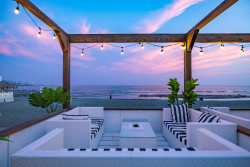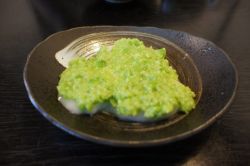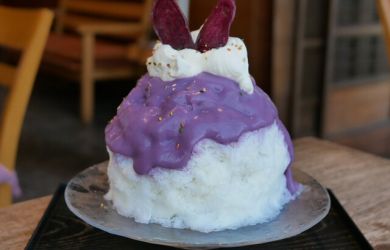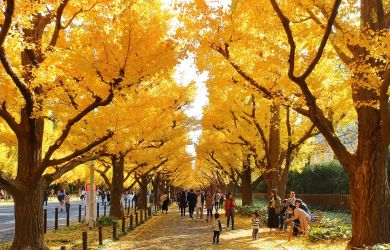
February 15, 2007
Aoni Onsen
Return to a forgotten time at one of Honshu’s most remote getaways
By Metropolis
Originally published on metropolis.co.jp on February 2007

Photos by Nathan Palmer
Aoni Onsen was established over 70 years ago by a disabled poet seeking solitude in the mountains of Aomori Prefecture. Until six years ago, it was accessible in winter only by snowmobile, but nowadays the narrow, winding road is plowed—yet still treacherous, as we found out when our van lost control on the ice, skidded into a ditch and got stuck. The perils of the commute, however, were more than justified by the pleasure of staying at Aoni.
Our destination, a rustic ryokan located in a tiny valley deep in the idyllic mountains of Shirakami, has no electricity. Lit by oil lamps, it assumes the alpine, monastic air of pre-modern Japan.
We arrived as the blue winter light of dusk was fading over the snow. Long icicles hung from the roofs of the traditional wooden buildings. The reception area of the main hall was painted with Buddhist frescos of monks, half enveloped in darkness. The dim lighting wasn’t for aesthetic reasons; we were warned that turning the lamps up could result in them overheating and exploding. Obviously, there was no television, although a generator-powered karaoke machine can be rolled out for special occasions. In short, there was nothing to do but bathe, talk, drink—and eat.

Aoni Onsen uses fish and vegetables taken from the local rivers and forests to create a simple, healthy and hearty menu for breakfast and dinner. We ate under flickering lamp light, seated at long tables in the dining hall. The winter menu included locally caught river fish, skewered and roasted in a charcoal pit; duck cooked in a mini nabe; a rich miso-based tofu soup called kenojiru; and a selection of tempura, fried vegetables and tsukemono. Many of the vegetables are picked from the mountains, and vary with the season. Some varieties include warabi, zenmai and an edible form of the acacia flower that appears in springtime.
After eating we took a soak in the onsen. There are four baths; one of which is located outside, offering spectacular views of a large waterfall.

Our tatami room was located in a pastoral wooden country house, with a sliding door that opened out onto a pond and rock garden. We wondered if this was how wealthy Japanese spent all their time in centuries past, but later learned that onsen ryokan were not always the expensive, luxurious lodgings they are today. In ancient times they operated more as cheap long-term accommodation for the elderly or sick. These days, there are still a few wealthy elderly customers who reside for long periods at Aoni Onsen, but more for health reasons than as a vacation.
Winter, when the trees and ground are dusted with a heavy blanket of snow, is maybe the most beautiful time to visit. Guests can take a 15-minute ride on the inn’s snowmobile for ¥1,000. Between May and October, lodgers can walk in the surrounding forest, or take in spectacular mountaintop views of Mt. Iwaki and Mt. Hakoda. Sato-san, the grandson of the onsen’s poet founder, says the surrounding forest is alive with deer, sables and serows—small, antelope-like creatures.
“At the moment, you can hear the serow foals at night, crying like infants,” he said. We fell asleep that night listening to the haunting sounds of this resident of the Japanese wild.
On our return journey to Tokyo, we made a visit in the castle town of Hirosaki. Here, we were stopped by two policemen, who asked to see my alien registration card. Unbeknownst to me, my visa details were out of date, which resulted in us having to visit the local police station to clear up the misunderstanding. We ended up discussing the Aoni Onsen.
The policeman said he’d stayed there, but vowed he would not soon return. “There was no television and it was a bit dark,” he noted casually, with a hint of scorn—that only made us smile, and look forward to our next trip to lost Japan.
Aoni Onsen is a little difficult to get to, but is well worth the trouble. Coming from Tokyo, take the Hayate shinkansen to Hachinohe, then the Super Hakucho express to Aomori. From there, take the JR Ou line to Hirosaki, and change to the Konan line. Get off at the final stop, Kuroishi. During the summer, customers can call ahead and be picked up at the station. Otherwise, you’ll have to take a bus to Nijinoko Koen. If you buy your tickets from the bus terminal and say you’re staying at Aoni Onsen, you’ll get half-price on return fare (don’t forget to have your ticket stamped at the onsen before leaving). Bookings can be made by telephone (0172-54-8588), but call well in advance. Information on the ryokan is available on its website (http://www.yo.rim.or.jp/~aoni/). Per person rates (includes breakfast and dinner are ¥9,075 from April to September, and ¥10,650 from October to March. Aomori Prefecture is also a great place for hiking and skiing; more information can be found on its English website (www.pref.aomori.lg.jp/en).
[geo_mashup_map]







